How to Choose the Best eCommerce Platform for Clothing [2024]
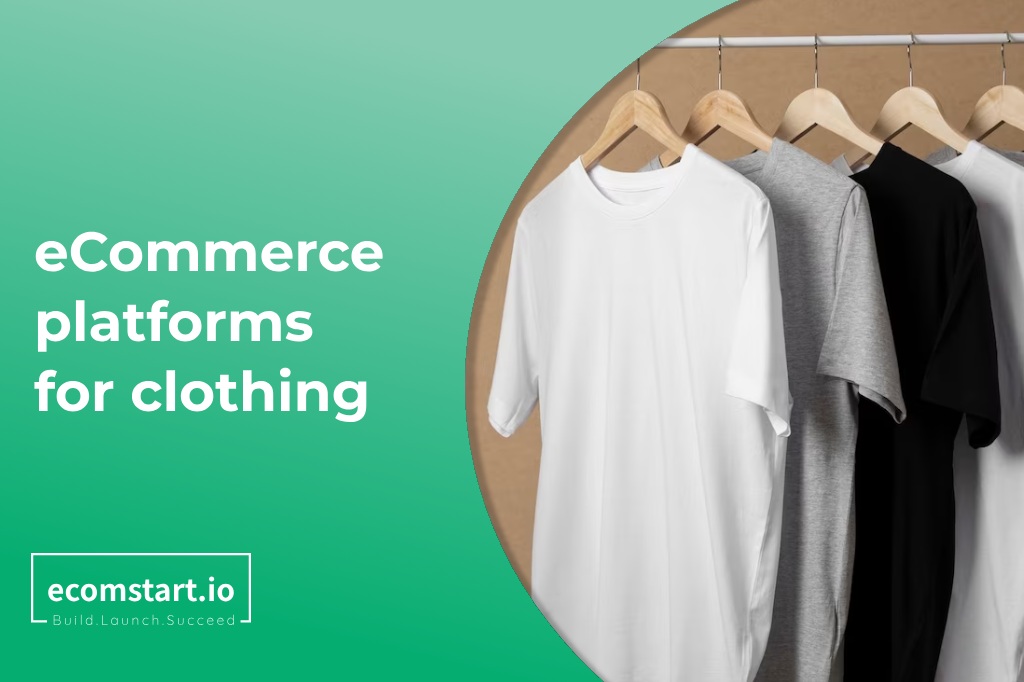
eCommerce revenues in the fashion industry are expected to rise from $180.5 billion in 2021 to $295.7 billion by 2025. In the US market, this number is also anticipated to increase, at least through 2027. Not to mention that impulsive purchases are typical behavior in online clothing shopping and the growing trend of reselling in the online fashion industry. The growth of this industry appears to be risk-free. If you want to get into the eCommerce fashion business, you’ll probably find the numbers above appealing. We will walk you through the best eCommerce platform for clothing in this article.
1. What is an eCommerce platform?
1.1. Definition
Similar to how a company needs premises to place a brick-and-mortar store, an eCommerce platform serves as an online location for your digital store. It offers web storefronts for the sale of products and services, as well as a plethora of features, tools, plugins, and services for order fulfillment and inventory management.
Product catalog management, order processing, payment gateways, shipping and delivery management, and marketing and analytics tools are a few of the essential features that eCommerce platforms provide.
For new users, the majority of eCommerce platforms offer free pricing plans with limited features. A certain annual or monthly charge is required of users – the more expensive plans offer more advanced features.
1.2. Type of some eCommerce platforms
There are typically 4 types of eCommerce platforms:
Open-source platforms
The open-source platform allows users the highest level of access privileges to any part of the source code, therefore, anybody can customize it to fit their individual needs. This would be a suitable decision for companies that desire a private eCommerce environment.
Saas eCommerce platforms
SaaS (software-as-a-service) is a subscription-based service provided by a 3rd party vendor where customers merely rent the software without having to acquire additional skills in designing, building, and maintaining the software platform.
Hosted platforms
Fully-hosted eCommerce solutions provide storage of your store, and the related documentation within the cloud. Instead of having to set up your own server and store the data on it yourself, the eCommerce platform stores your data for you.
Self-hosted platforms
Self-hosted eCommerce is an eCommerce platform whereby your organization provides the hosting services. This implies that you will have to host a server, most often in the cloud, and you will store all information concerning your store there.
3. Why is choosing the right eCommerce platform important for clothing business?
Operating on eCommerce platforms is becoming an inevitable requirement rather than a trend for businesses. All kinds of businesses across all sectors, from global conglomerates to small-town grocers, whether B2B, B2C, or D2C, are moving toward digitalization. The majority of the time, benefits take precedence, and the best eCommerce platform for clothing will undoubtedly help your company grow to new heights.
A prominent place on search engine results pages, for instance. Or maybe you need a platform that makes it simple for you to customize your store if you’re not tech-savvy or have little experience with design. Not to add, the automatic features of the right eCommerce will help you save a ton of valuable time when selecting a fashion eCommerce platform.
If you already have an online store on one eCommerce platform, learning about other platforms won’t hurt. You are not a displacementist, you just simply have a vision, and migrating or scaling up your store should always be considered if you are a visionary business owner.
4. How to choose the best eCommerce platform for your clothing store
4.1. Identify your needs
To know oneself is true progress. Consider your company’s needs as well as the products you sell. For instance, the types of clothing and whether they have any particular requirements, product variations, sales volume, degree of customization the platform can handle, payment gateways, shipping options, etc. Consider the types of media and product descriptions that the platform can offer for your store as well. Make a list to help you choose the best eCommerce platform by reducing the options based on those requirements.
4.2. Consider your budget
“How much does it cost to start a clothing line?” is a common question. Everything would be so much easier if you didn’t have to talk about money. But this is business, so be realistic and think about your company’s budget – something that should be mentioned in the identify your needs step but is worth mentioning separately. What you have is one thing, what you are willing to spend on an eCommerce platform is another. You get what you pay for, and different pricing plans will provide different features. Keep in mind that pricing varies across platforms as well – some may charge a transaction fee, while others may require payment if a third-party payment gateway is used.
4.3. Research the platform
After you have a clear understanding of your store’s needs as well as your budget, you can begin looking for the best platform for selling clothes. Let’s compare pricing plans and examine the features available on each platform. It’s also a good idea to see how well it integrates with other platforms and plugins. Furthermore, if problems arise during use, customer support is critical. Don’t forget to read the review. Internet research is also useful, but be cautious because most of the top list articles are from a platform attempting to promote their own products and services.
4.4. Start a free trial
The free trial is a free feature available on almost every platform that many people often overlook. To utilize the free trial, try out every possible feature to get the most objective view of the platform. Try importing a few clothing items as well as information about their variants, setting up payment gateways, delivery methods, and other customizations. These actions also give you the customer’s point of view when browsing through your store, allowing you to make the best assessment of the platform’s suitability and effectiveness for your store.
4.5.Think about scalability
As your company grows – and it will – you’ll need a platform that can handle increased traffic and sales. Nobody wants your website to be completely down during major shopping occasions such as Black Friday. Scalability is therefore an important consideration when selecting an eCommerce platform, and the platform you choose must be able to scale with your business. Consider this factor carefully to avoid having to switch to another platform as your store grows.
4.6. Consider your knowledge base
A number of those platforms might also involve professionalism or coding for setting up and maintaining an online store. Go for platforms with simple interfaces and user-friendly tools if you do not have much experience in these areas. Moreover, ascertain whether the platform offers tutorials, documentation, or community forums for guidance. Ensure the platform you pick will offer you an opportunity for self-hosting since you do have not much skill in techs.
5. Top 5 best eCommerce platforms for clothing
Though there are many eCommerce platforms, not all of them work well with apparel products. For clothing products – unlike digital devices or books – you need an eCommerce platform that will allow customers to select variants of the same product (colors, sizes, materials,…). You don’t need a platform that works, you need a platform that works well. A good platform should help you efficiently manage your products and provide a good customer experience.
5.1. Shopify
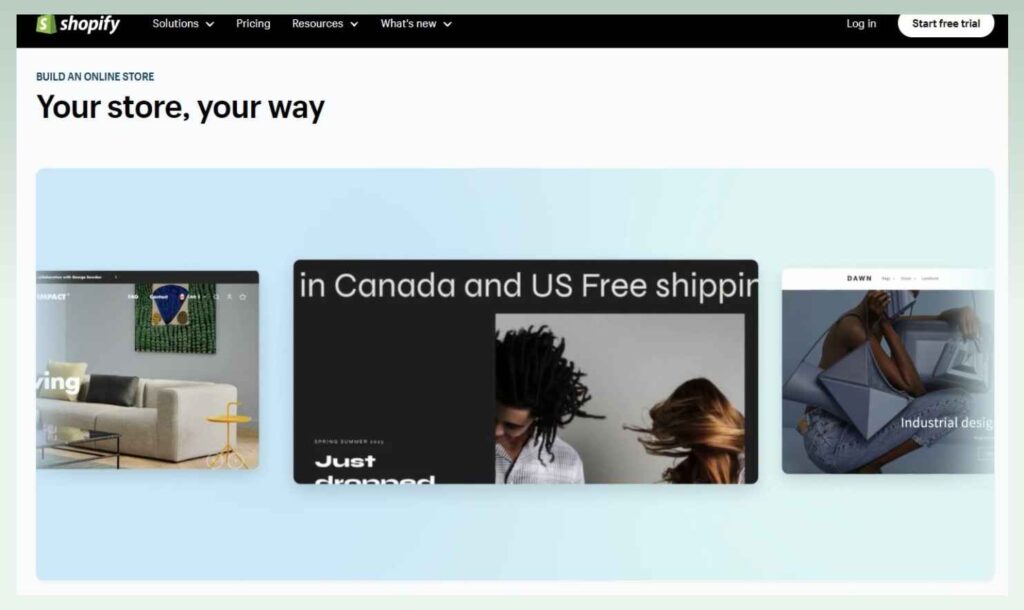
Shopify remains one of the most commonly used eCommerce options. User-friendly, comprehensive feature suite, good customer service, ease of customization, and smooth integration with other platforms characterize it as competitive. Shopify is especially ideally suited if you also possess a brick-and-mortar store. The company has a market share of about 10%.
We have a comprehensive guide on how to sell clothes on Shopify that may be helpful for you, as it is one of the most widely used platforms not only in the fashion industry.
Pros
- Multiple eCommerce features and integrations are provided
- Wide-ranging customization features that can provide CSS and HTML, and editable themes.
- Allows for additional delivery alternatives with multiple third-party integrations
- Apps specifically optimized for dropshipping
- Robust app marketplace
- Extensive multi-currency support and advanced global functions
Cons
- The steeper learning curve for beginners
- Transaction fees are charged to third-party payment gateways
- Complexity for smaller businesses
- Extra expenses on some themes
Pricing plan
- Basic (FOR INDIVIDUALS & SMALL BUSINESSES): $29/month
- Shopify (FOR SMALL BUSINESSES): $79/month
- Advanced (FOR MEDIUM TO LARGE BUSINESSES): $299/month
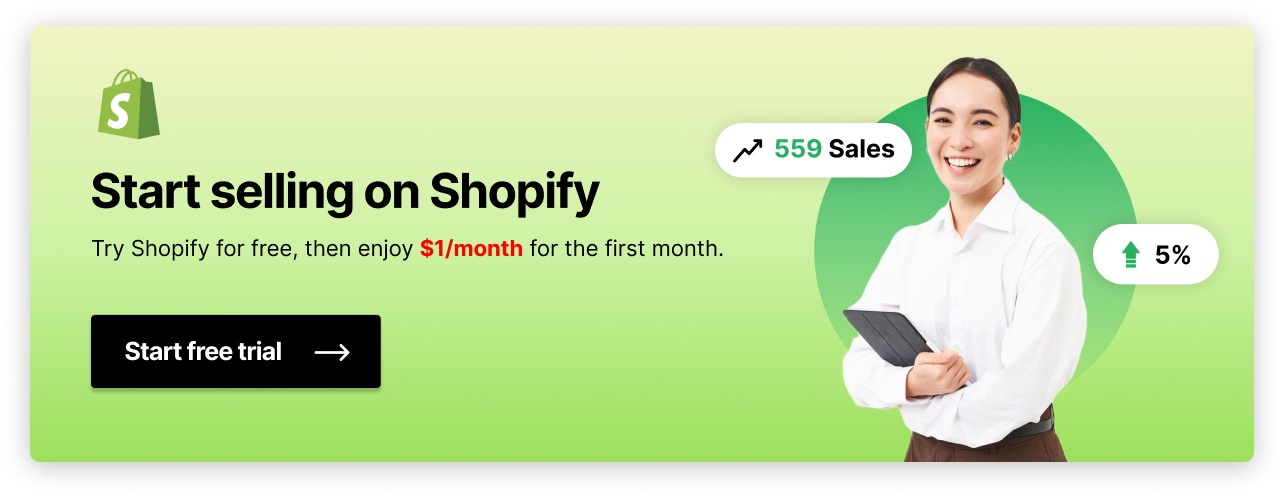
5.2. Magento
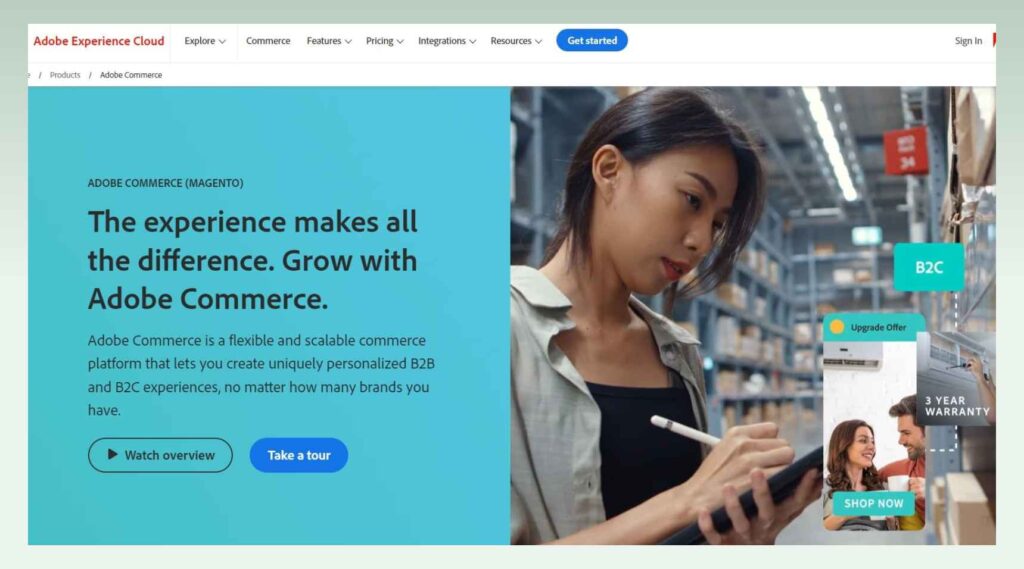
Magento is an open-source e-commerce platform which grants you access to many customizable themes and modules in Magento to suit your business needs. It has become an open-source content management system (CMS) so well-known that everyone in this field must know. Apart from other platforms, Magento stands out among the competitors with its flexibility and ability to integrate with third-party applications. Magento has a market share of almost 2%.
Pros
- Highly customizable platform
- Comprehensive feature set
- API integration capabilities
- Powerful analytics reporting
- Zero transaction costs and flexible payment methods
- Supportive user community
Cons
- Complex installation process
- Technical knowledge requirements
- Pricing plan is expensive compared to competitors
- Lack of mobile-compatible themes
Pricing plan
- Magento Open Source: Free
- Adobe Commerce: $22,000 to $125,000/year, with additional costs including:
- Web hosting: $14.99 to $39.99/month
- Domain: $10 to $20/year
- SSL certificate: $50 to $600/year
- Web developer: Hourly cost based on the expertise of the developer
- Transaction fees: factor in 2% to 4% per transaction for payment platforms and credit card processing fees
5.3. Wix

Wix encompasses an end-to-end web building as well as an eCommerce solution. It is unique from the rest due to its drag-and-drop builder that allows users to easily customize their stores with different templates and designs. Wix has an array of features that have been well-tested and certified by experts, and effective client support service. Approximately 6% constitute the market share of Wix.
Pros
- Built-in SEO plugins enhanced search engine rankings
- Do not need any coding knowledge
- Directly connect your website to Google Search Console and Google Analytics
- Flexible customization options
- No transaction fees required
- Excellent customer service
Cons
- Can’t export your website to other platforms
- Slow speed loading
- Tags and archive pages duplicated
- Limited scalability
- Pricing plans are more expensive compared to competitors
- Poor API integrations
- Lack of powerful analytics reporting tools
Pricing plan
- Connect Domain: $4.50/month
- Combo: $8.50/month
- Unlimited: $12.50/month
- VIP: $25.50/month
5.4. BigCommerce
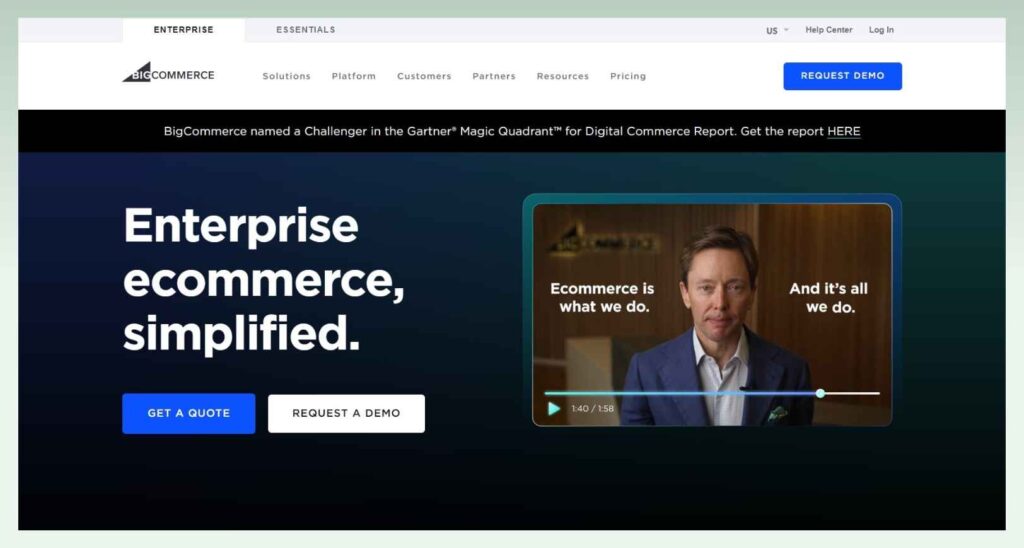
BigCommerce has already become known as an eCommerce platform for clothing and accessories businesses. It is user-friendly, with built-in responsive themes that adapt depending on screen sizes. Additionally, you can sell on Amazon, eBay, as well as others with BigCommerce. The market share for BigCommerce is approximately 3%.
Pros
- Easy to set up and user-friendly interface
- Mobile-friendly themes and templates
- Most of their built-in templates are compatible with Google’s AMP
- Image optimization feature
- Broad array of plugins and themes
- Robust analytics reporting capabilities
Cons
- Sluggish loading speed
- Custom typefaces are not supported
- Expensive pricing plans compared to competitors
- Limited developer support
Pricing plan
- Standard: $39 per month
- Plus: $105 per month
- Pro: $399 per month
- Enterprise: varied, depends on your business’ needs
5.5. WooComemrce

WooCommerce is an open-source eCommerce solution built on WordPress. It stands out from the others with its ease of use and ability to integrate with WordPress plugins, which gives you access to thousands of free and paid plugins to add features to your clothing store. WooCommerce has a market share of around 36%.
Pros
- Seamlessly integrates with any site running on WordPress
- Strong SEO advantages
- Built-in data analysis tool
- Numerous customization options
- Zero initial cost
- Supportive developers community
Cons
- Lacking compatibility with non-WordPress sites
- Hidden expenses from plugins and features on premium options
- Limited scalability for larger businesses
- Poor API integration capabilities
Pricing plan
The platform is free but with the possibility of upgrading to a Premium plan. Some expenses could include:
- Hosting: from $6.95/month
- Domain name: from $15/year.
- Communications: free to $348/year
- SEO: free to $79/year
- Security: free to $300/year
- SSL certificate: typically free but could cost up to $65 per year
6. What factors should you consider when selecting an eCommerce platform for clothing
6.1. Web hosting
Web hosting has a very big implication on the success of your eCommerce clothing brands, as it acts as a digital space for you to place your online store. It is where your website is hosted and hence your web content is stored, processed, and served.
However, web hosting is hardly a one-size-fits-all concept. In terms of the technical foundations on which the site stands, hostings are where one should look since these are basically what makes the site work.
A reliable web hosting, at the very least, should provide secure payment, unlimited bandwidth allotments, and storage space. Brand loyalty research carried out by global communications firm Edelman shows that about 25% of online customers feel trusted towards certain brands that have successfully secured their information.
6.2. Ease of use
The best eCommerce platform for clothing should be user-friendly, so it’s okay even without deep knowledge of technological stuff. While most platforms would let you post your items at a flick of a button, there is always room for experimenting with various parameters like product details or order flow configurations. If it all seems as though something your future visitors would like to see every day, then you’ll have saved yourself a couple of hours in advance.
Among the most easy-to-use eCommerce platforms in addition to having a clean interface, one of them is Shopify which allows for creating and handling an online store without any coding knowledge by utilizing an easy-to-use drag-and-drop page builder. Squarespace is another good option because it has tools designed specifically for fashion retailers as well as drag-and-drop design features. WooCommerce is another option, with dozens of templates available to help design everything from blogs to shop pages.
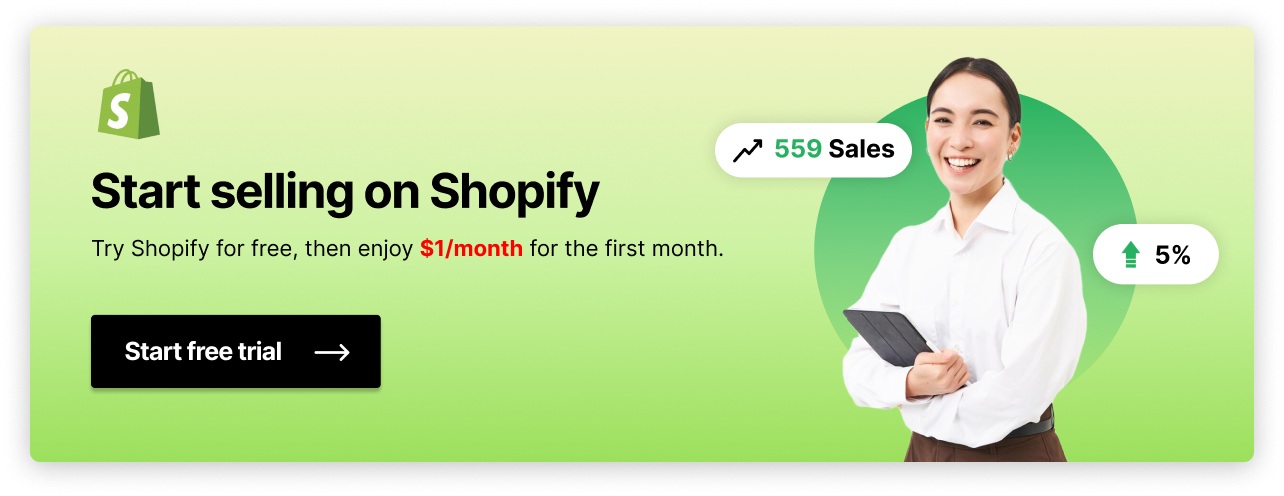
6.3. Customization flexibility
eCommerce platforms must be flexible enough to allow for easy customization to minimize your workload. For example, you need to create product pages, storefronts, and email campaigns to run your business. As such, the best eCommerce platform for clothing should enable users to alter colors, fonts, logos, photos, and content layouts for promotional deals, special offers, and categories.
Platforms that have limited customized features such as Shopify are not suitable for one looking for full control in customizing your clothing eCommerce website, although it does not require coding knowledge. For some, Magento could be considered the best for customizability because it represents extreme possibilities for controlling the view, feel, and functions of a website. Drupal often ranks first amongst customizable eCommerce platforms, however, it requires proficient skill in coding.
6.4. Product catalog
All online stores refresh their product catalogs as often as brick-and-mortar shops regularly update their inventory and window displays to excite their customers. You need a complete product catalog, which will highlight the breadth of choice you can offer clients. eCommerce catalog management is a term that describes the whole activity of organizing, managing, and updating the products of the online shop. This covers everything ranging from product descriptions, pictures, pricing, inventory as well as all the information published on the site.
Failure to manage product catalogs is expensive. Salsify’s report indicated that 87% of consumers found product content as either extremely or very critical in purchase decisions.
If your business is a big one with large product catalogs, then Magento and BigCommerce can handle it smoothly. If you are a startup or medium-sized online store, Shopify is still a good option.
6.5. Order management
Businesses can smoothly run their operations, keep a record of their inventory, control customer orders, and make sure that products are delivered on time using an efficient order management system. It prevents mistakes, enhances customer satisfaction, and increases sales capacity.
Several popular eCommerce platforms like Magento, BigCommerce, Shopify, and WooCommerce provide superior functionality in order management, which encompasses a timely update on inventories, monitoring of orders, and coupling up with the shipment providers.
On the other hand, Prestashop – which does not have an integrated warehouse management system – may not be well-functioned in case you wish to perform order fulfillment and inventory tracking.
6.6. Payment options
Don’t let down your future clients and lose potential customers during the checkout process. Especially when today’s payment methods are no longer just limited to the question ”cash or card?”, but also include payment wallets, UPI, cryptocurrency, and more. A good store in the eyes of customers are ones that can provide them with several options to pay for their bills. This implies that it is very crucial to pick a system that can support many means of payment.
If you’re a starter store, a small brand, or already possess a physical store, then Shopify is ideal since it has multiple payment options and requires no transaction fee. However, you may still be required to pay if you choose a third-party payment gateway. Numerous other platforms also offer many common gateways, such as Magento, OpenCart, Prestashop,…However, SquareSpace’s payment options are limited because the platform only accepts Stripe and PayPal.
6.7. Inventory
The eCommerce platform must also be able to support large inventories as well. Ideally, it should not charge according to the number of listed products, since apparel is an industry that often requires a large inventory. We may sum up eCommerce inventory management as a mix of the following tasks: Locating, tracking, tallying, managing variety, controlling the prices of different kinds of supply items, and acting as a mediator between your suppliers and clients. Thus, ensure that you choose a platform that provides live inventory management functions and automatic refilling orders.
If your business is a B2C one with a somewhat larger inventory compared to small stores, then you should choose BigCommerce or Magento. Wix and Prestashop, once again, are not what you are looking for since they have very few built-in features and do not integrate with other inventory management software.
✨ Consider using a POS system from our list of the best POS system for clothing store free to help you manage your inventory more efficient.
6.8. Shipping partners
Choosing shipping partners will influence the expediency, dependability, and expense efficiency of order realization. It is imperative to evaluate whether an eCommerce platform can be synced with different delivery methods and includes built-in shipping options.
For example, Shopify provides easy integration with well-known carriers like United Parcel Service (UPS), United States Postal Service (USPS), and FedEx where one can effortlessly create shipping labels, trace their cargo items, and offer current charges at the time. In addition, Magento is integrated with several shipping carriers such as DHL, USPS, and UPS making it easy for business owners to manage shipping. There are several shipping extensions on WooCommerce, which integrate with USPS, FedEx, or Canada Post among others.
6.9. Analytics
The analytic aspect allows an apparel business to measure its online eCommerce site, identify trends, and make informed choices based on those given data. These offer insights on prospects, make marketing better, and enhance customer experience. For a clothing brand to measure its efficacy, it must have access to analytical tools in its eCommerce platform.
Wix enables you to directly connect your clothing eCommerce website to Google Analytics – one of the best-known analytics tools. Shopify is equipped with built-in analytics that offer full-scale reports covering sales revenues, customers’ patterns of behavior concerning products and services, as well a comprehensive summary for the corresponding marketing campaigns. This enables a company to be able to monitor vital parameters like conversion rate, average order values, and customer lifetime value. Magento is rich in analytical capabilities such as user-friendly customizable dashboards, customer segmentation, marketing analysis that encloses sales forecasting among several others.
6.10. Integration capabilities
Enabling seamless business operations necessitates integrating it with both in-house and third-party systems, software, and plugins. To start with, the best eCommerce platform for clothing should be effortlessly compatible with your present stock management. Furthermore, the platform should be connected to other social media like Facebook, Instagram, Pinterest, and Twitter to promote brand consciousness and sales improvement.
Magento offers a wide-ranging API for integration with third-party applications and social media, as well as eCommerce platforms like Amazon. Bigcommerce provides full support for Drupal and WordPress integrations.
Shopify provides integrations for a variety of tools – email marketing platforms, inventory management systems, and social media, allowing businesses to connect and sync their data with ease. Shopify’s API, in addition to its inherent capabilities, enables developers to forge custom integrations and construct unique functionalities that precisely address specific business requirements.
6.11. Audience-building & marketing tools
There are audience-building and marketing tools that must be taken into account while picking an eCommerce platform for clothing. These utilities will draw new clients, hold them interested, and cause them to come back once again, leading to increased sales and profits.
For example, platforms such as Shopify provide a built-in capability for email marketing and are compatible with renowned email marketing providers, including Mailchimp. These include integrations with retargeting and personalization solutions such as Google Ads, Facebook Pixel, and Klaviyo.
However, WooCommerce does not have any specific built-in marketing features. Therefore, if your company depends on SEO and other methods of acquiring customers then it would be a better idea to find somewhere else for that.
6.12. SEO friendliness
Certainly, as an entrepreneur or a merchant delving into the vast realm of eCommerce, you grasp the concept of SEO: In a nutshell, it is one way of boosting the organic traffic to the website either by quantity or by quality. In essence, poor applications of SEO render your website invisible to your customers.
Both BigCommerce and Shopify offer numerous SEO tools such as inbuilt 301 redirects, enabling users to customize robots.txt or URL structure for a more user-friendly feel. Small business owners can opt for Weebly, which has a basic plan that offers services without charge. However, they can only remove their ads if you upgrade to a premium plan.
6.13. Scalability
As a small business, a startup, or a beginner in the digital apparel industry, you can choose a platform with basic features that fit your budget. However, as your business grows, or simply when your store needs many other requirements such as high traffic, the platform you choose must be capable of handling them. You should not choose to switch to another platform because this costs time and effort. To simplify this problem, from the very beginning, you should choose a platform with scalability capabilities so that it accompanies you over time.
During Prime Day in 2018, Amazon’s website could not withstand the heavy flow of web traffic. The bug persisted for one hour and it is believed that Amazon lost approximately $1,000,000 per minute since it happened at the busiest time of Prime Day. You can see that it all boils down to scalability.
BigCommerce will be an ideal application for you in case your store happens to be of a smaller scale but you also want to scale your operations. On the other hand, Big Cartel, which mostly caters to individual hobbyists and entrepreneurs, does not target large companies or fast-growing startups.
6.14. Security
Everywhere is going digital, which means cyber crimes are increasingly rampant. Therefore, a good eCommerce store should be a place where customers feel secure, especially when checkout. You have to take care of the timely updates, as well as security certifications all the time.
The use of Advanced Encryption Standard AES-256 for passwords while other data such as credit card info and addresses are encrypted using the secure hash algorithm SHA-256 makes Magento one of the most highly secured platforms. Shopify and BigCommerce are both Level 1 certified, each covered by multiple security layers. WooCommerce is secure, however, it is the responsibility of the store owner to ensure that it stays so. You also noted it as a concern that OpenCare is an open-source system and its source code is available to everyone.
6.15. Customer support
The best eCommerce platform for clothing should also consider providing technical support or documentation for developers or business owners. Besides, you can opt for an open-source technology that has a vast developer community.
BigCommerce and Shopify provide free on-the-call phone support and technical support on a 24/7 basis. Support services offered by Magento include documentation, a help center user’s guide, and Magento forum, and so forth. However, in comparison, Prestashop has low customer support and minimal training documentation.
7. Successful clothing and apparel eCommerce websites to take inspiration from
7.1. Gymshark
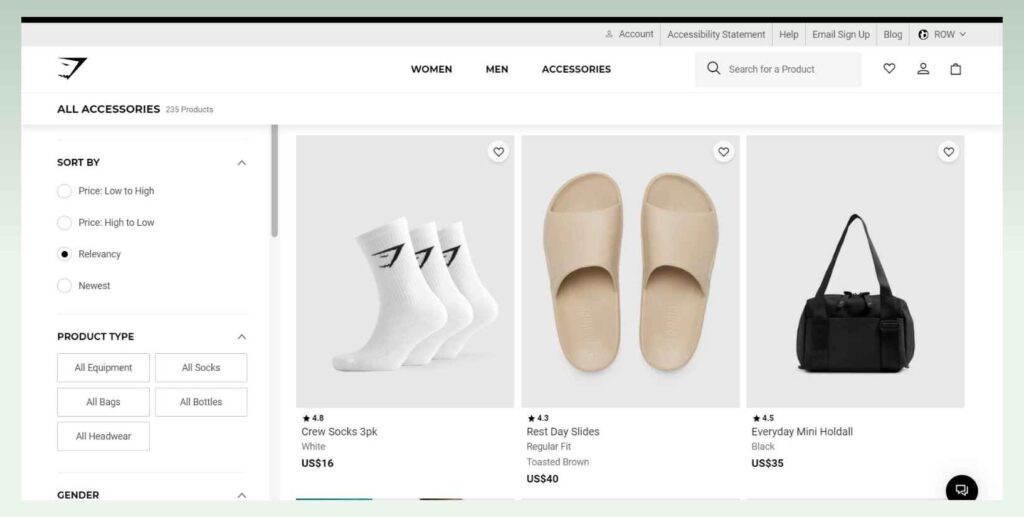
Replatforming to Shopify following its failed attempt to settle in Magento, Gymshark is an international brand with global recognition going beyond the sportswear industry to apparel at large.
Gymshark uses Shopify POS to deliver immersive online-offline customer experiences. Additionally, their Shopify stores boast of a sales-friendly user interface. Rollover images and a ‘Quick Add’ feature are used together, such that they enable a customer to quickly include the product desired in their carts without having to navigate through a product page or click off.
7.2. Amundsen Sports

Amundsen Sports is a clothing brand that specializes in winter sport-related apparel and accessories. They operate through a website running on WooCommerce and have large product catalogs containing many men’s and women’s items.
A visitor may easily navigate within or between the men’s or the women’s collection, directly from the home page.
This image of Amundsen has been placed in an acceptable resolution that makes it possible to let the guests get an idea of what they could have with the products or brands of this company. The brand also utilizes the integration feature to use Instagram perfectly to promote their store.
7.3. Dress Up
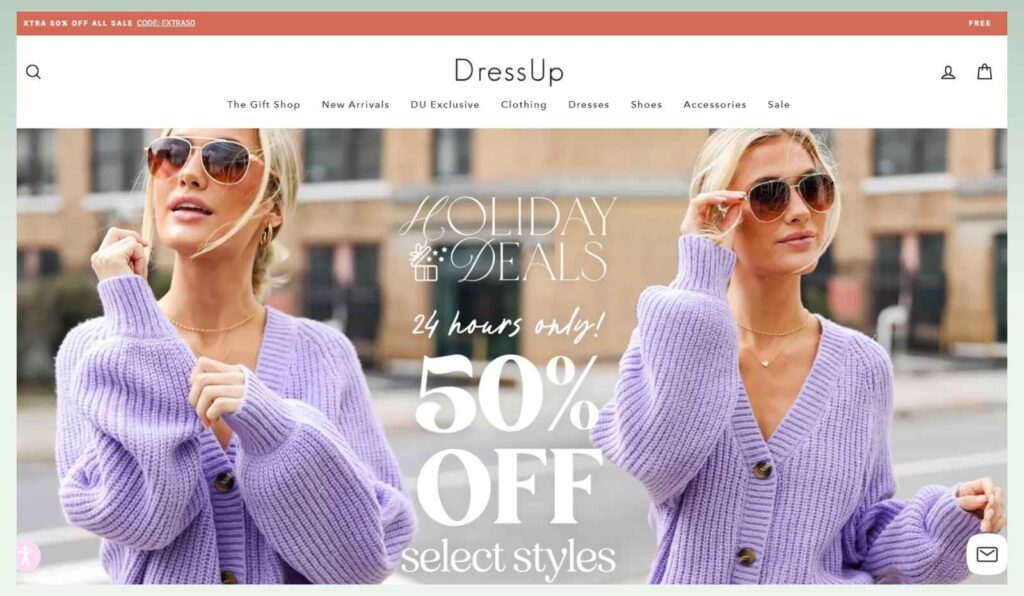
Dress Up is a clothing brand with a wide range of categories. In less than ten years, they opened 19 stores with around three hundred employees each.
They started with Shopify, but due to the need for several different app-based integrations, they stopped. Within a couple of weeks, Dress Up moved to BigCommerce and then utilized BigCommerce’s API integrations with a few favorite apps and many platform-included apps. Their revenue increased 19% in year one since launched and is projected for annual growth ever after that.
8. 5 common mistakes to avoid when choosing an eCommerce platform
In business, every mistake can be converted into money – or a lot of money. So, below are the most basic mistakes that you should at least try to avoid and save trial and error for larger-scale things in your business operations.
8.1. Not considering the scalability potential
As mentioned many times in this article, even if you are just a small business or a startup that even using a telescope you still don’t see the day when your business becomes big with many branches, then at least you have to consider the following factors: the store’s rising needs when it comes into operation. You cannot predict when high traffic will come to your store, or the need for inventory will suddenly increase when the market has a new trend. You can’t just consider switching to another platform as a permanent option, because it will be like moving your entire house. So, consider scaling as your business’s long-term goal and choose a platform that suits your potential.
8.2. Ignoring mobile compatibility
Although currently, the number of smartphone users has reached billions, and that is not even including other mobile devices, but many businesses still ignore the compatibility factor with mobile devices when choosing an eCommerce platform. Make sure the platform you choose has themes and designs that are responsive to different screens – tablets, smartphones, and even smart TVs. This will ensure customers can shop at your store from right on their smartphones, at any time.
8.3. Ignoring integration prospect
Not to mention integrating with other platforms, the minimum thing an eCommerce platform should have is smooth integration with other tools and software. You can’t rely on just built-in plugins available on every platform, because your store’s needs will certainly be more than that.
8.4. Neglecting security factors
As a business owner, you will have many things to consider when choosing an eCommerce platform. However, as a buyer, security is still a top priority. They need to keep their personal information confidential, both when purchasing and when making payments, and of course do not want their phone number to be bothered by other companies such as real estate or employment scams. Therefore, platforms with SSL certification, secure payment gateways, and fraud prevention measures,… are at least important in protecting both your store’s information and customer data.
8.5. Not considering customer support and regular updates
Maybe you don’t require 24/7 customer support, but at least the customer service on the platform you choose should answer questions quickly, not wait a few days to respond. Especially when you pay for that platform and customer support is part of the costs you have to spend. In addition, a regularly updated platform is also something that should not be overlooked. Fashion can be vintage and rotate, but your business cannot.
9. Conclusion
After all, choosing the best eCommerce platform for clothing is still completely up to you. A platform is good for one store doesn’t mean it will be good for another. A platform that does not charge an initial fee may still incur other costs. We can present important factors to consider, and give suggestions and examples of successful businesses in the eCommerce apparel market, but in the end, the person who understands your business best is still you. Therefore, do not rush to make a decision, clearly determine the costs and capabilities of your business first.
Hopefully, the above instructions will act as a guidebook that you can use at any time in your journey to conquer the eCommerce market.


